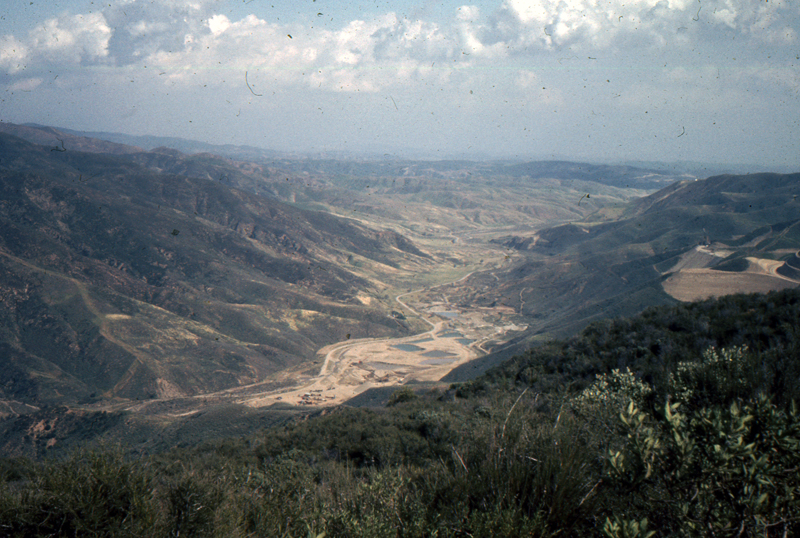View of the Elderberry Forebay of Castaic Lake from the Ridge Route, 1967-70.
The DWR facility is under construction here.
Ridge Route history by Jerry Reynolds:
Ever since the days of Phineas Banning, General Beale and the Butterfield Overland stage,
vehicles made their way out of Los Angeles, through San Francisquito Canyon, down the Grapevine
Pass, and then into Bakersfield. The California Highway Commission was formed in 1911, and one of
its first priorities was to build a simpler, more direct road through the La Liebre Mountains.
That task fell to the man with the unlikely name of W. Lewis Clark.
Frustrated in several attempts to locate an easy way across the stony barrier, Clark, at last,
blazed a trail right over the top from the mouth of Castaic Canyon to Gorman. It was called the Ridge Route.
After a year of toil, during which four-horse Fresno scrapers graded hilltops alongside chugging
Caterpillar tractors to the tune of a staggering half-million dollars, the Tejon Route, as it was originally
dubbed, opened to the motoring public late in November 1915. The Auto Club did a little calculating,
finding that in the 36 miles between Castaic and Gorman, there were 642 curves that added up to 97
complete circles. It did cut 60 miles off the road, however.
Even before construction started in 1914, an enterprising businessman by the name of Sam Parsons
purchased an acre of land from W.H. Cook fronting the stake line, then threw up a general store that
catered to the needs of the workers. Afterwards, "Sam's Place" became a mecca for truckers
and the beginning of a new town called Castaic.[...]
While the Ridge Route did not bring permanent residents (to the Santa Clarita Valley), for the most part it did cut down on
travel time to the great markets of Los Angeles. One could journey to town and back in a single day —
amazing! Then there was the increasing horde of gentlemen clad in long linen dusters with goggles,
piloting their chugging, spitting vehicles with names such as Marmon "41," Winton "Six," or Packard ("Ask the man who
owns one"). They, their womenfolk, and children might get hungry along the way or need gasoline
or automobile repairs. So began a series of what might be called "tourist traps." [...]
The next stop (after Newhall-Saugus) along the Ridge Route would have been Castaic, (and then) there
was the Ridge Road Garage, The Tumble Inn, Reservoir Summit, and that splendid establishment
in the wilderness known as Sandberg. Local rancher Herman Sandberg provided excellent, guaranteed-fresh
steaks at his hotel. Slot machines could also be found there and, in a long, low building out back (known
as "The Crib,") feminine companionship was available for weary truckers and lonely salesmen. [...]
In 1933 Highway 99 was carved up the canyons, bypassing the 18-year-old Ridge Route, which was already
antiquated.
About the photographer:
James Krause was a 20-year-old art and history student at San Fernando Valley State College (now CSUN) when, in February 1967, his family moved to 19549 Fairweather St. in Saugus — later called Canyon Country. After graduating in 1968 and aspiring to become a teacher, James worked at the Flare-Northern division of the Atlantic Research Corporation in Saugus, a defense subcontractor that manufactured explosive devices for Sandia National Laboratories in Albuquerque, New Mexico. Flare-Northern was located at 19701 W. Goodvale Road, in the hills west of the Krause home.
Lucky for us, James enjoyed touring the canyons and shot numerous photographs from 1967-1970, focusing particularly on Soledad Canyon from present-day Canyon Country
to Acton, and on its Southern Pacific Railroad features. He shot many of the photos in November 1970 while on leave from Vietnam. His teaching pursuits had been derailed; he entered the Army on Nov. 5, 1968, and went through basic and infantry training at Ford Ord, Calif., followed by NCO training at Ft. Bening, Geo. In October 1969 he served as a staff sergeant with the 101st Airborne Division in the northernmost part of South Vietnam, operating from the DMZ to an area near the Laotian border. In November 1970 he transfered to the 14th Armored Cavalry (later the 11th Armored Cavalry) in West Germany, patrolling the border with East Germany until his discharge in March 1973. By that time, the earthquake of Feb. 9, 1971, had hit the Santa Clarita Valley and his family moved away from Saugus.
James' early interest in railroads was no passing fancy. Following his military service he joined the Union Pacific Railroad, first as a maintenance-of-way foreman for about a year and then as a locomotive engineer, a position he held until his retirement Aug. 29, 2011 (except for brief try at the restaurant business from 1992 to 1995). He drove trains in California, then Missouri and finally in Texas, where he lives as of 2012. He had three children with his first wife who, like James, was a Union Pacific Railroad engineer in Southern California. According to James, the UP believes they may have been the first husband-and-wife locomotive engineers in the United States.
JK0021: 9600 dpi jpeg from color transparency (slide) | Digital image only | Archival scan on file



